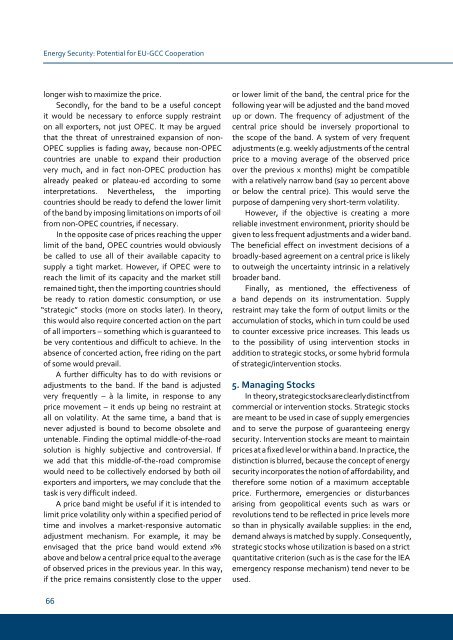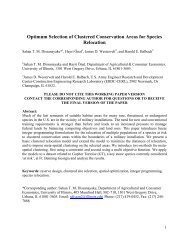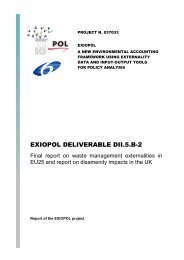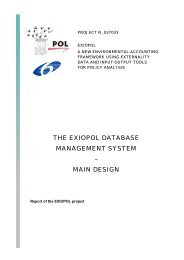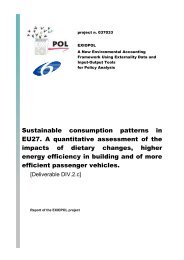Gulf and European Energy Supply Security - Feem-project.net
Gulf and European Energy Supply Security - Feem-project.net
Gulf and European Energy Supply Security - Feem-project.net
You also want an ePaper? Increase the reach of your titles
YUMPU automatically turns print PDFs into web optimized ePapers that Google loves.
<strong>Energy</strong> <strong>Security</strong>: Potential for EU-GCC Cooperation<br />
longer wish to maximize the price.<br />
Secondly, for the b<strong>and</strong> to be a useful concept<br />
it would be necessary to enforce supply restraint<br />
on all exporters, not just OPEC. It may be argued<br />
that the threat of unrestrained expansion of non-<br />
OPEC supplies is fading away, because non-OPEC<br />
countries are unable to exp<strong>and</strong> their production<br />
very much, <strong>and</strong> in fact non-OPEC production has<br />
already peaked or plateau-ed according to some<br />
interpretations. Nevertheless, the importing<br />
countries should be ready to defend the lower limit<br />
of the b<strong>and</strong> by imposing limitations on imports of oil<br />
from non-OPEC countries, if necessary.<br />
In the opposite case of prices reaching the upper<br />
limit of the b<strong>and</strong>, OPEC countries would obviously<br />
be called to use all of their available capacity to<br />
supply a tight market. However, if OPEC were to<br />
reach the limit of its capacity <strong>and</strong> the market still<br />
remained tight, then the importing countries should<br />
be ready to ration domestic consumption, or use<br />
“strategic” stocks (more on stocks later). In theory,<br />
this would also require concerted action on the part<br />
of all importers – something which is guaranteed to<br />
be very contentious <strong>and</strong> difficult to achieve. In the<br />
absence of concerted action, free riding on the part<br />
of some would prevail.<br />
A further difficulty has to do with revisions or<br />
adjustments to the b<strong>and</strong>. If the b<strong>and</strong> is adjusted<br />
very frequently – à la limite, in response to any<br />
price movement – it ends up being no restraint at<br />
all on volatility. At the same time, a b<strong>and</strong> that is<br />
never adjusted is bound to become obsolete <strong>and</strong><br />
untenable. Finding the optimal middle-of-the-road<br />
solution is highly subjective <strong>and</strong> controversial. If<br />
we add that this middle-of-the-road compromise<br />
would need to be collectively endorsed by both oil<br />
exporters <strong>and</strong> importers, we may conclude that the<br />
task is very difficult indeed.<br />
A price b<strong>and</strong> might be useful if it is intended to<br />
limit price volatility only within a specified period of<br />
time <strong>and</strong> involves a market-responsive automatic<br />
adjustment mechanism. For example, it may be<br />
envisaged that the price b<strong>and</strong> would extend x%<br />
above <strong>and</strong> below a central price equal to the average<br />
of observed prices in the previous year. In this way,<br />
if the price remains consistently close to the upper<br />
or lower limit of the b<strong>and</strong>, the central price for the<br />
following year will be adjusted <strong>and</strong> the b<strong>and</strong> moved<br />
up or down. The frequency of adjustment of the<br />
central price should be inversely proportional to<br />
the scope of the b<strong>and</strong>. A system of very frequent<br />
adjustments (e.g. weekly adjustments of the central<br />
price to a moving average of the observed price<br />
over the previous x months) might be compatible<br />
with a relatively narrow b<strong>and</strong> (say 10 percent above<br />
or below the central price). This would serve the<br />
purpose of dampening very short-term volatility.<br />
However, if the objective is creating a more<br />
reliable investment environment, priority should be<br />
given to less frequent adjustments <strong>and</strong> a wider b<strong>and</strong>.<br />
The beneficial effect on investment decisions of a<br />
broadly-based agreement on a central price is likely<br />
to outweigh the uncertainty intrinsic in a relatively<br />
broader b<strong>and</strong>.<br />
Finally, as mentioned, the effectiveness of<br />
a b<strong>and</strong> depends on its instrumentation. <strong>Supply</strong><br />
restraint may take the form of output limits or the<br />
accumulation of stocks, which in turn could be used<br />
to counter excessive price increases. This leads us<br />
to the possibility of using intervention stocks in<br />
addition to strategic stocks, or some hybrid formula<br />
of strategic/intervention stocks.<br />
5. Managing stocks<br />
In theory, strategic stocks are clearly distinct from<br />
commercial or intervention stocks. Strategic stocks<br />
are meant to be used in case of supply emergencies<br />
<strong>and</strong> to serve the purpose of guaranteeing energy<br />
security. Intervention stocks are meant to maintain<br />
prices at a fixed level or within a b<strong>and</strong>. In practice, the<br />
distinction is blurred, because the concept of energy<br />
security incorporates the notion of affordability, <strong>and</strong><br />
therefore some notion of a maximum acceptable<br />
price. Furthermore, emergencies or disturbances<br />
arising from geopolitical events such as wars or<br />
revolutions tend to be reflected in price levels more<br />
so than in physically available supplies: in the end,<br />
dem<strong>and</strong> always is matched by supply. Consequently,<br />
strategic stocks whose utilization is based on a strict<br />
quantitative criterion (such as is the case for the IEA<br />
emergency response mechanism) tend never to be<br />
used.


